The plastic crisis will be the focus of Earth Day 2024. EarthDay.org introduced its #PlasticDetox…
The post Take a Stand Against Plastic for Earth Day 2024 appeared first on Earth911.

The plastic crisis will be the focus of Earth Day 2024. EarthDay.org introduced its #PlasticDetox…
The post Take a Stand Against Plastic for Earth Day 2024 appeared first on Earth911.
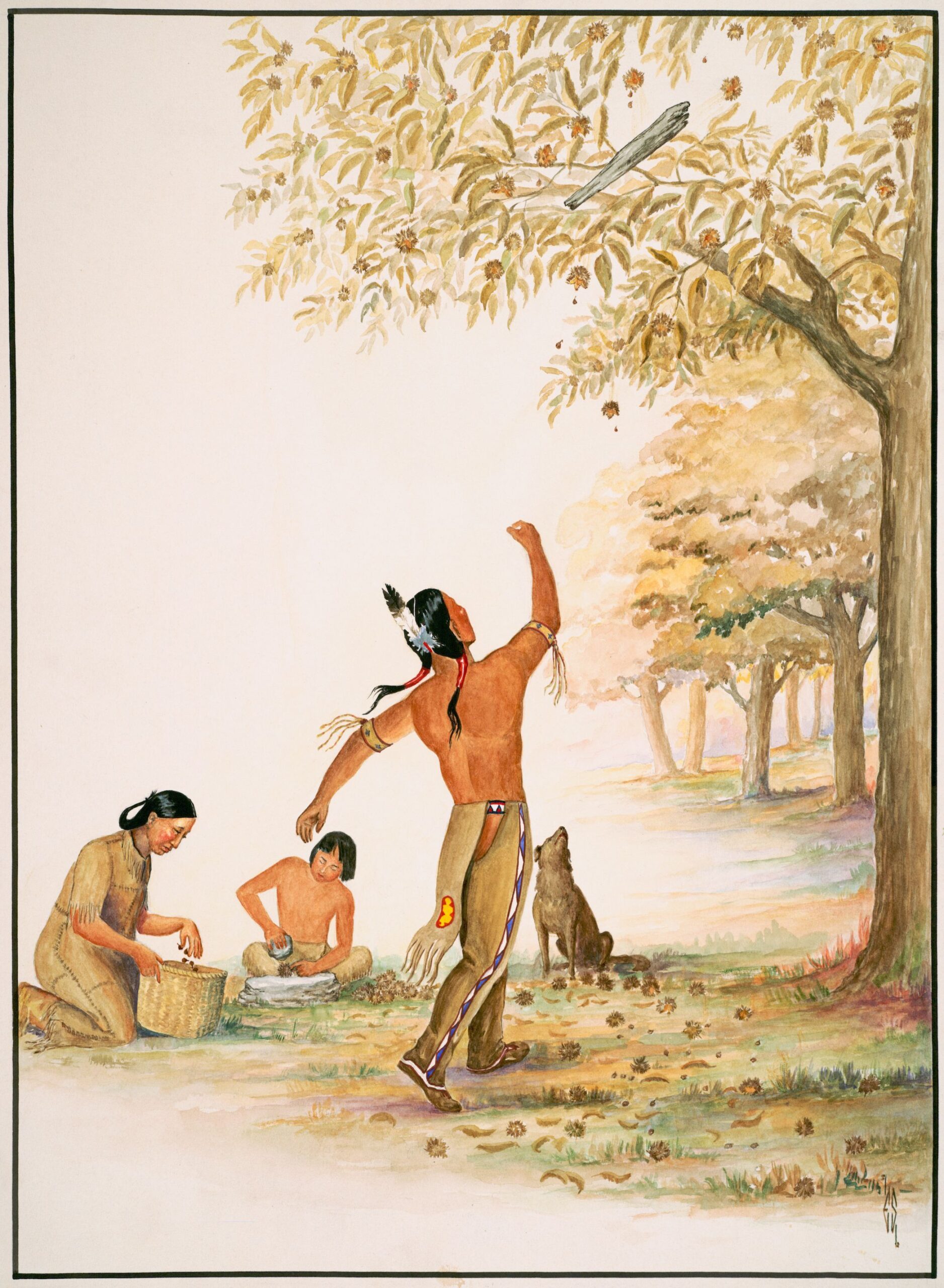
This story was co-published with Native News Online.
When Neil Patterson Jr. was about 7 or 8 years old, he saw a painting called “Gathering Chestnuts,” by Tonawanda Seneca artist Ernest Smith. Patterson didn’t realize that the painting showed a grove of American chestnuts, a tree that had been all but extinct since his great-grandparents’ time. Instead, what struck Patterson was the family in the foreground: As a man throws a wooden club to knock chestnuts from the branches above, a child shells the nuts and a woman gathers them in a basket. Even the dog seems engrossed in the process, watching with head cocked as the club sails through the air.
Patterson grew up on the Tuscarora Nation Reservation just south of Lake Ontario near Niagara Falls. The painting reminded him of his elders teaching him to harvest black walnuts and hickories.
“I think, for me, it wasn’t about the tree, it was about a way of life,” said Patterson, who today is in his 40s, with silver-flecked dark hair and kids of his own. He sounded wistful.
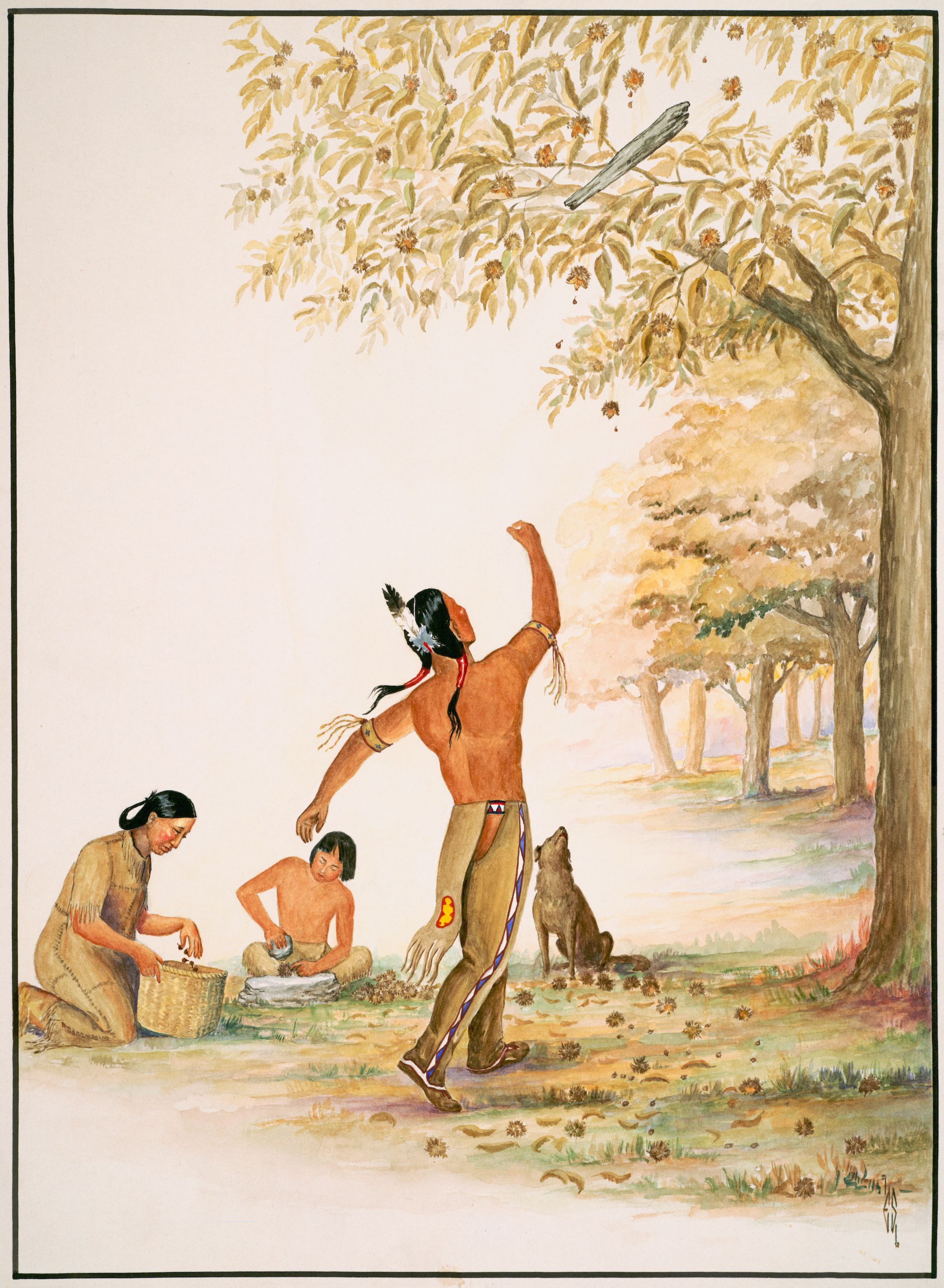
The American chestnut tree, or číhtkęr in Tuscarora, once grew across what is currently the eastern United States, from Mississippi to Georgia, and into southeastern Canada. The beloved and ecologically important species was harvested by Indigenous peoples for millennia and once numbered in the billions, providing food and habitat to countless birds, insects, and mammals of eastern forests, before being wiped out by rampant logging and a deadly fungal blight brought on by European colonization.
Now, a transgenic version of the American chestnut that can withstand the blight is on the cusp of being deregulated by the U.S. government. (Transgenic organisms contain DNA from other species.) When that happens, people will be able to grow the blight-resistant trees without restriction. For years, controversy has swirled around the ethics of using novel biotechnology for species conservation. But Patterson, who previously directed the Tuscarora Environment Program and today is the assistant director of the Center for Native Peoples and the Environment at the State University of New York’s College of Environmental Science and Forestry in Syracuse, has a different question: What good is bringing back a species without also restoring its traditional relationships with the Indigenous peoples who helped it flourish?
That deep history is not always clear from conservation narratives about the blight-resistant chestnut. For the past four decades, the driving force behind the chestnut’s restoration has been The American Chestnut Foundation, a nonprofit with more than 5,000 active members in 16 chapters. Before turning to genetic engineering, the foundation tried unsuccessfully to breed a hybrid chestnut that looked and grew like an American chestnut but had genes from species native to Asia that gave it blight resistance. “Our vision is a robust eastern forest restored to its splendor,” reads The American Chestnut Foundation’s homepage, against a background of glowing green chestnut leaflets. “Our mission is to return the iconic American chestnut to its native range.”
But the Foundation website’s history of the tree begins during colonial times, suggesting a romantic notion of a precolonial wilderness that ignores the intensive agroforestry that Indigenous peoples practiced. By engineering vanished species to survive harms brought on by colonization without addressing those harms, people avoid having to make hard decisions about how most of us live on the landscape today.
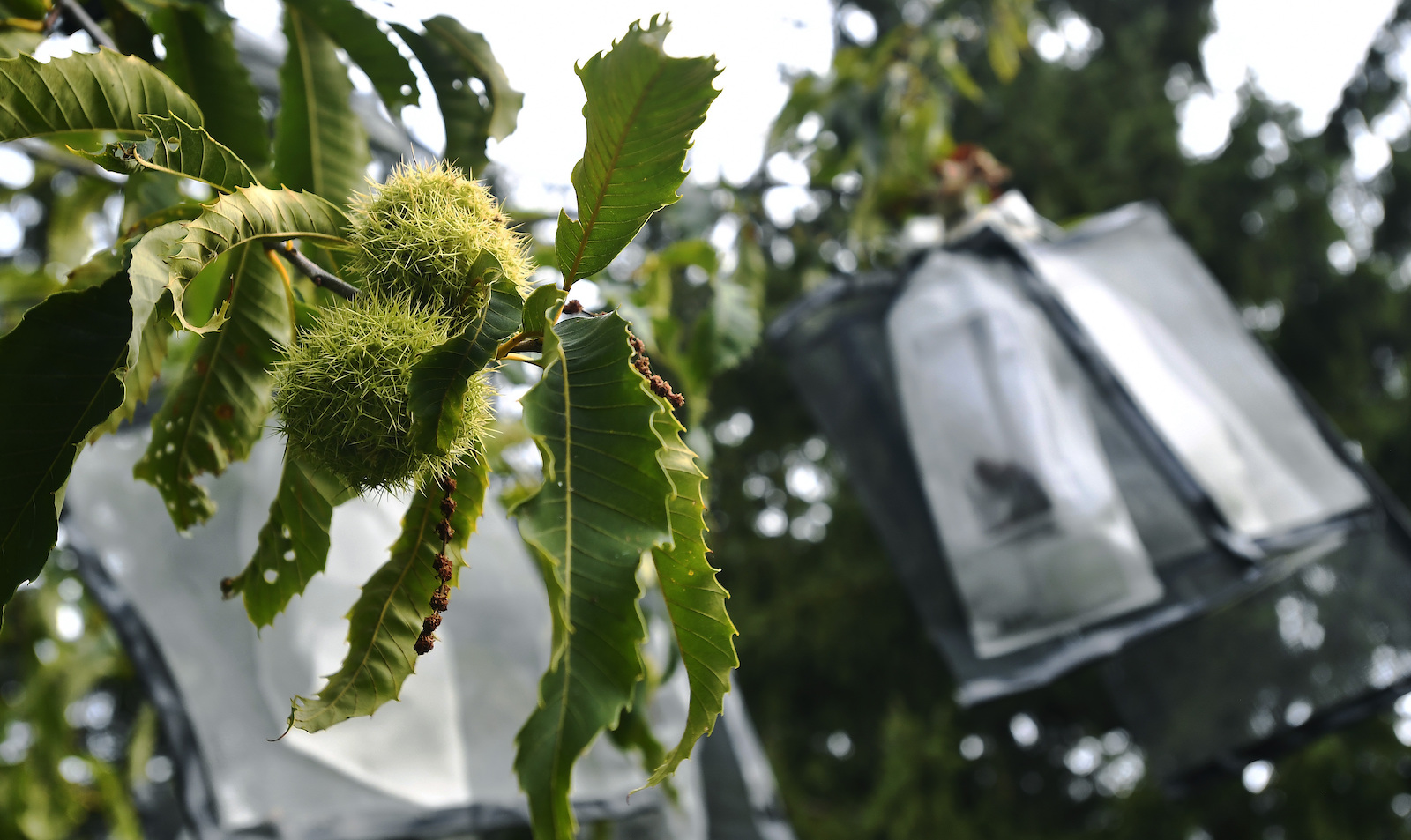
Bill Powell began working on chestnut genetics when he was a 28-year-old graduate student in Utah, which is actually outside the tree’s natural range. Now in his late 60s, with silvery hair, glasses, and an infectious curiosity about the relationship between tree and pathogen, he’s a leading chestnut restoration expert.
When I met Powell in 2022, he fretted that the chestnut restoration process was taking too long. “Unfortunately, I see retirement on the horizon,” he told me. “But not anytime soon, because I have to get this done.” At the time, Powell was a colleague of Patterson’s, working for the same university and directing the American Chestnut Research and Restoration Project. Since then, as the blight-resistant tree has wound its way through the deregulatory labyrinth of federal agencies including the Environmental Protection Agency, Food and Drug Administration, and Department of Agriculture, Powell has had to step down, recently sharing his diagnosis of terminal colon cancer publicly.
When we spoke, Powell stressed that after the blight-resistant chestnut is deregulated, no Indigenous nations will have to grow the transgenic trees on their lands if they choose not to. But he acknowledged that this does not reassure those who think of Indigenous land not in colonial terms, meaning within reservation boundaries, but instead in terms of treaty rights or cultural practices on historic tribal lands. Indigenous nations, including members of the Haudenosaunee Confederacy such as the Tuscarora Nation, have long argued that even when they ceded land to colonial governments, they did not cede their rights to access and care for plants and animals on those lands.
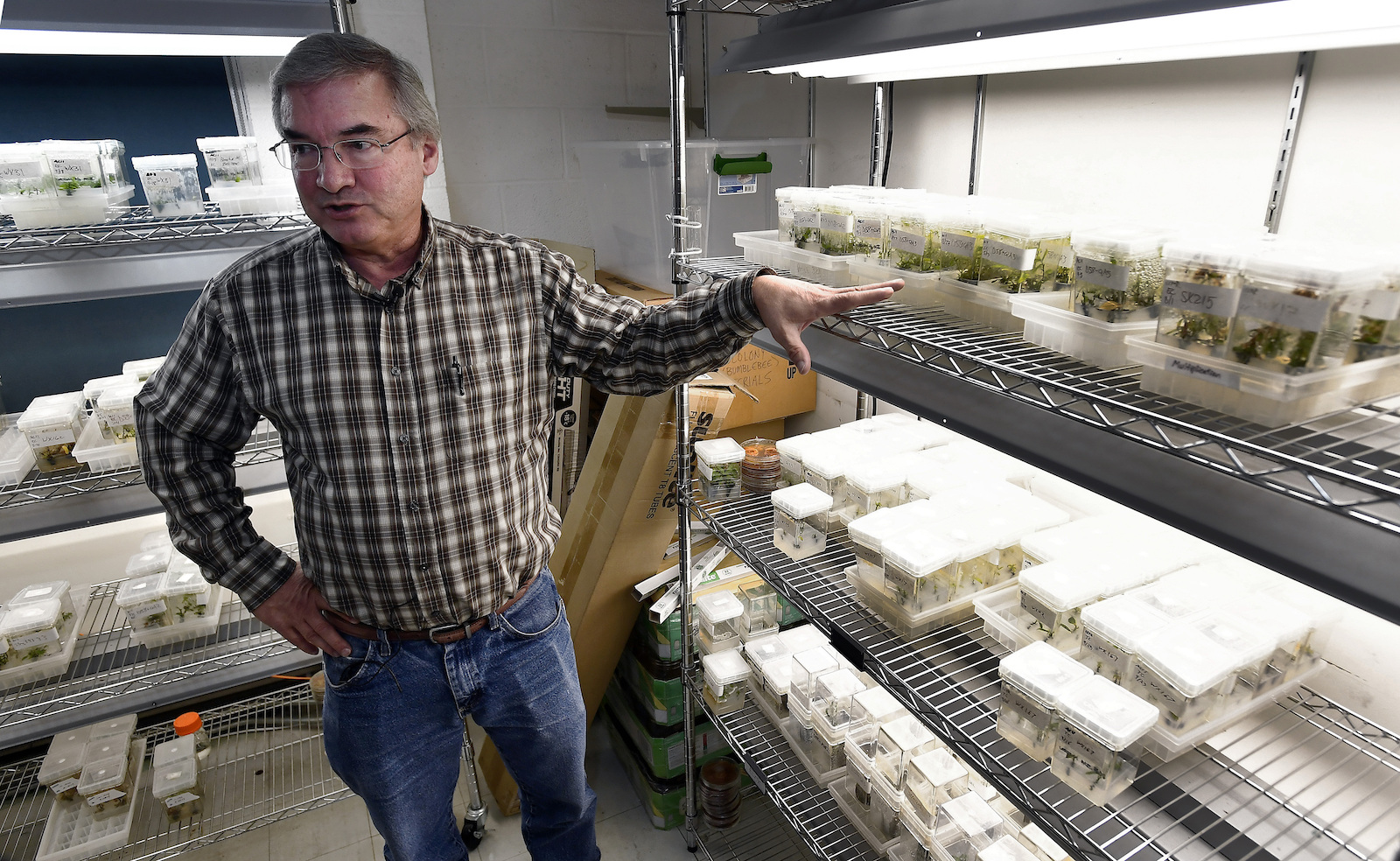
The nuts of the American chestnut are small, sweet, and nutritious. They were an important part of the varied diet that sustained Patterson’s ancestors for millennia; in return, people cared for groves of the trees across thousands of miles. When the United States pushed Indigenous peoples throughout the chestnut’s range off their lands, and the American chestnut became functionally extinct, an ancient reciprocal relationship vanished, too.
“We were instructed to pick those nuts,” Patterson said. “And when we don’t pick them, the plant goes away.”
With craggy bark and shaggy branches of feathery leaves, the American chestnut could reach 100 feet tall during its heyday. Its trunk could be 13 feet wide. The trees huddled along the Gulf Coast for some 8,000 years during the most recent ice age, sheltering in the relatively warm stretch from Florida to the Mississippi River, because mountain peaks even in the southernmost part of the Appalachians were too cold for chestnut trees to grow. Then, as the snow receded northward 20,000 ago, the trees slowly migrated from their coastal refuges. They worked their way up the Appalachian Mountains — helped by Indigenous peoples, whom they helped in turn.
The trees dropped an avalanche of chestnuts to the forest floor each year. According to historian Donald Edward Davis, people burned low fires that dried the nuts and killed off chestnut weevils. By suppressing other plants, fires helped the chestnut trees spread, and the nuts became staples of Indigenous diets — a reliable source of nutrition that people stored in earthen silos or pounded into flour for chestnut bread and other foods. The human-tended groves also fed animals such as elk, deer, bison, bears, passenger pigeons, panthers, wolves, and foxes. Chestnut logjams in streams created deep, clear pockets of water where fish could thrive. Several species of invertebrates relied on chestnut trees for habitat; after the trees died out, five species of moths went extinct.
European settlers forced Indigenous peoples along the chestnut’s range from much of their homelands, severing access to plants and animals they’d long interacted with. Meanwhile, settlers cut down chestnuts for many reasons — to clear space for towns and farms; to build fence posts, telegraph poles, and railroads; or just to gather the nuts more easily.
Nevertheless, the chestnut survived for centuries. Enslaved people gathered chestnuts to supplement meager meals and to sell. White Appalachian communities came to rely on chestnuts as free feed for their hogs and other livestock, and as a cash crop.
Then, in the late 1800s, horticulturalists imported trees carrying the fungal blight Cryphonectria parasitica to the United States. The blight spread by wind and splashing rain; it also hitched rides on insects and birds. Once it landed on the bark of a new tree, it dug in through weak spots — old burn injuries, insect wounds, or scars left from woodcutting — and dissolved the tree’s living tissue with oxalic acid, creating angry orange streaks and open cankers on trunks. The trees would die back to their roots, resprout, and die back again, like botanical zombies. The blight killed at an astonishing pace. All told, a tree whose ancestors evolved millions of years ago died out in less than 50 years.
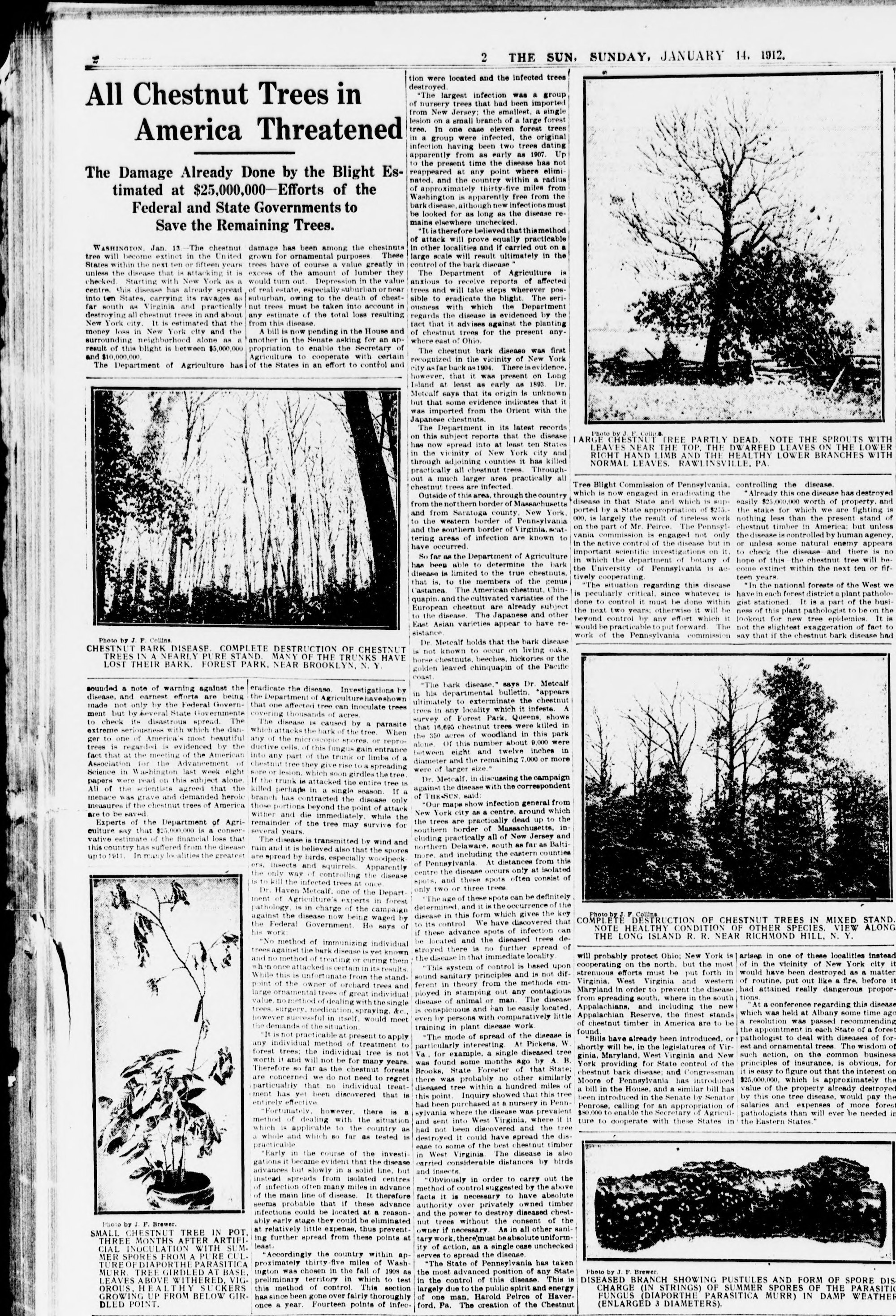
In turn, the chestnut lost the people whose practices helped it thrive. Patterson told me that some Indigenous nations even lost their word for the chestnut tree, because chestnuts disappeared at the same time that the U.S. government took Indigenous children, including at least one of Patterson’s own relatives, and placed them in boarding schools. In part, this was another strategy for coercing tribes to give up territory. Many children didn’t survive the schools, which were often run by Christian organizations. Those who did were forced to give up their languages, religious beliefs, and traditions. But chestnuts still inhabit Indigenous creation stories and religious calendars, and Patterson believes that a reciprocal relationship can be reestablished between Indigenous nations and the tree. He’s just not convinced that releasing the transgenic chestnut will restore those connections.
The Tuscarora Nation, of which Patterson is an enrolled citizen, is one of six Indigenous nations that today comprise the Haudenosaunee Confederacy, also known as the Iroquois Confederacy. The Haudenosaunee creation story, Patterson said, is “a cycle of loss, grieving, and recovery all the time, just like ecological succession.” By creating a genetically engineered chestnut, Patterson argues, scientists are avoiding the part of the cycle where people grieve and learn from their mistakes.
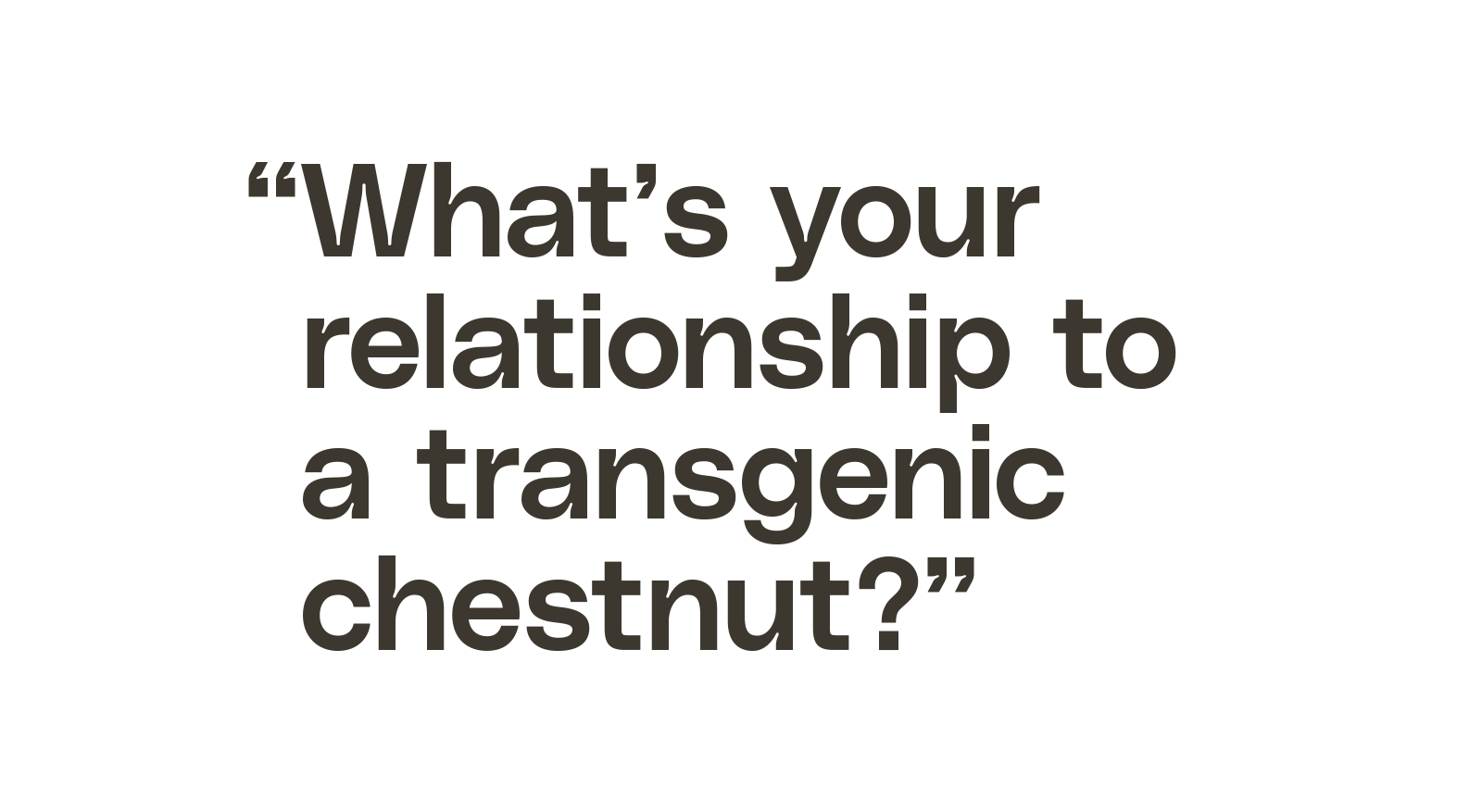
On the timescale of Haudenosaunee history, the losses still feel new. “It’s been 100 years — but that’s not long,” Patterson observed. Then he reconsidered. “That’s long for research scientists, or a plant technology innovator. It’s too long.”
To Patterson, what’s not being restored — treaty rights to access and care for plants and animals on the landscape — is telling.
“If you want to restore this, like, ‘primordial’ forest, don’t you also want to restore our relationship with that forest?” he asked. “Like — what’s your relationship to a transgenic chestnut?”
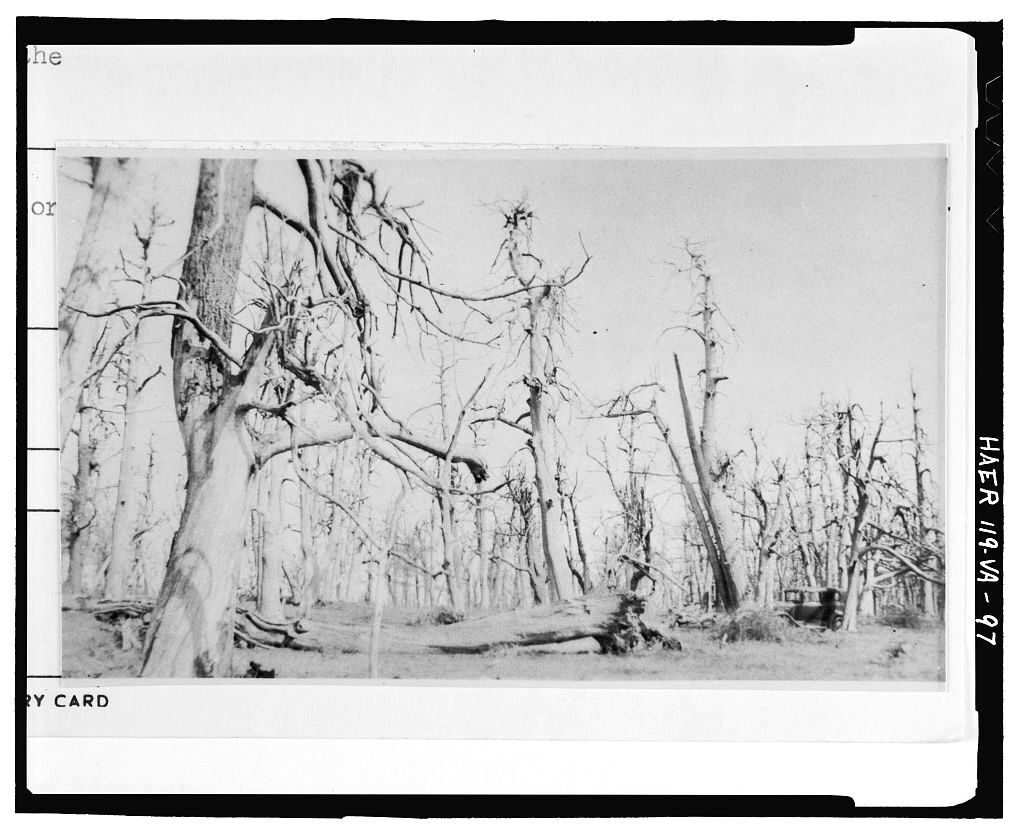
By the time Patterson first saw Ernest Smith’s artwork in the early 1980s, the Tuscarora Nation was going through a cultural renaissance. Patterson’s mother made her children speak Tuscarora at home to keep the language alive. His relatives participated in political acts such as the occupation of Wounded Knee by Indigenous people from across the U.S., in part to demand that the federal government uphold treaty obligations to the Lakota people. Murals on the walls of Patterson’s state-run elementary school showed Tuscarora people hunting, fishing, trapping, and gathering, even as non-Indigenous people contested those traditional activities outside of reservation lands, from the local to the national level.
Over time, Patterson was taught that the Haudenosaunee Confederacy never ceded its “reserved rights,” or rights that are not explicitly mentioned in treaties or court cases. Today, the Confederacy maintains that it still holds rights to care for and access the species growing on its ancestral homelands and in ancestral waterways — even in territory ceded to settlers. But both the state of New York and the federal government have chipped away at those reserved rights through court cases, and often won. In this legal context, harvesting chestnuts, like the family in Smith’s painting, is not only a cultural practice; it’s an exercise of tribal sovereignty.
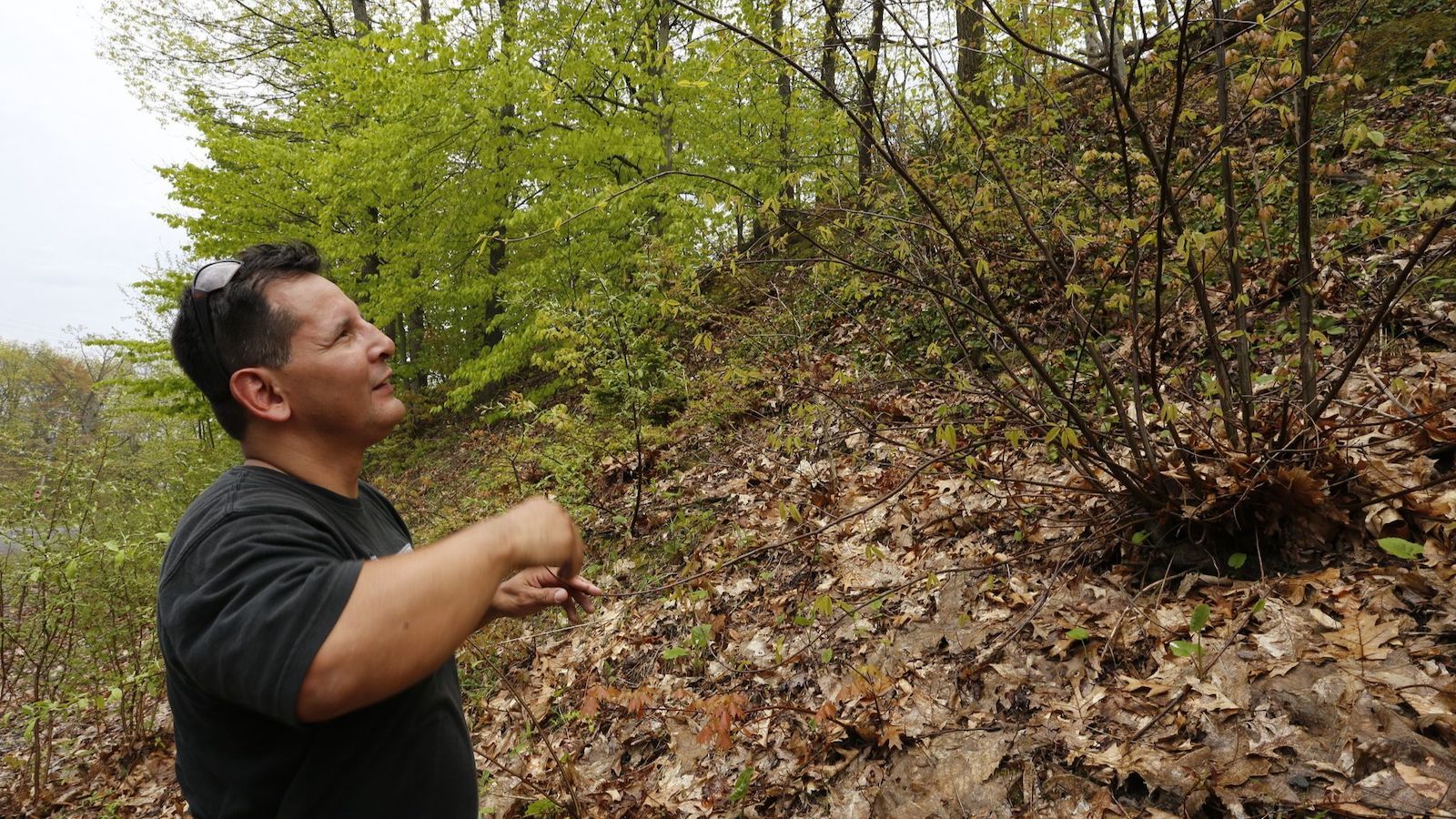
Patterson works to rebuild tribal access to many plants and animals that are culturally important for Haudenosaunee peoples. Because those plants and animals often live outside of reservation lands, his work can be difficult. New York State maintains that, except on reservation lands, Indigenous peoples have the same rights as non-Indigenous peoples, and have to follow the same regulations regarding when, where, and how much they hunt, fish, or gather, such as hunting seasons or fishing licenses — regulations the Tuscarora have been fighting in court for decades. So to Patterson, the question of whether to grow transgenic trees isn’t really the most urgent one. He’s more concerned about upholding a way of life that restores traditional ecological relationships.
“Aside from the whole issue of being transgenic, this is just about access and care of place,” he told me. In New York’s state lands, he added, there are almost no provisions for gathering medicines, collecting food, or growing food in traditional territories. Yet that reciprocity helped chestnuts spread and thrive across thousands of miles and thousands of years.
The Haudenosaunee Confederacy began making treaties with white settlers more than 400 years ago. The two-row wampum belt, made of rows of white beads run through with two rows of purple beads, documents a 1613 agreement between the Haudenosaunee and Dutch settlers to live in parallel, not interfering with each other’s ways of life. In 1794, during George Washington’s presidency, the Haudenosaunee and the United States signed the Treaty of Canandaigua, affirming the Confederacy’s sovereignty on its territory. In the Nonintercourse Act, a series of statutes passed in the late 1700s and early 1800s, Congress also barred states from purchasing lands from Indigenous nations without federal approval. When states’ land purchases are approved, Indigenous nations don’t lose any other rights on those lands, such as hunting, fishing, or gathering, unless the treaty specifically cedes those rights, explained Monte Mills, who directs the Native American Law Center at the University of Washington.
Nonetheless, states including New York still try to assert control over tribes or tribal resources, and in many cases, succeed. In one 2005 case, Patterson himself was the defendant, charged by the state of New York for ice fishing without properly labeling his gear. Patterson brought a copy of the Treaty of Canandiagua to court, explaining to the judge that as a member of the Haudenosaunee Confederacy, he had the right to fish in the state park, formerly Seneca territory, without regulation by the state of New York. Patterson lost that case.
The Supreme Court of the United States has also limited Haudenosaunee reserved rights, though from a different angle. In City of Sherrill v. Oneida Indian Nation of New York, decided just a few months before Patterson’s case, the Supreme Court ruled that although the Oneida Nation, which is part of the Haudenosaunee Confederacy, never gave up certain rights on its ancestral land, it had essentially waited too long to exercise them.
This particular case centered around whether tribes had to pay local and state taxes on ancestral land that they bought back on the real estate market. In the majority opinion, Justice Ruth Bader Ginsberg wrote that both Indian law and the need to treat people equally “preclude the Tribe from rekindling embers of sovereignty that long ago grew cold.” According to Mills, the Supreme Court essentially said that Oneida had let too much time pass to assert its sovereign rights, and therefore had lost them.
“It’s one of the worst decisions from foundational Indian law court,” Mills said. Although the case was about property taxes, Mills said that it could be a precedent for preventing Indigenous nations from exercising reserved rights. “The state would probably point to Sherrill and say, ‘No, you can’t have those rights, because you haven’t asserted them for so long,’” he added.
But Mills also pointed out that sometimes, tribes and states have been able to work together to come up with mutually beneficial ways for tribes to exercise their reserved rights. If states are interested in recognizing tribal sovereignty, he said, there are models out there for how to do it.
For its part, the state of New York has been working recently to improve its relations with Indigenous nations. In 2022, the state and the federal government agreed to return more than 1,000 acres to the Onondaga Nation. That same year, Governor Kathy Hochul’s administration created an Office of Indian Nation Affairs in the Department of Environmental Conservation, the same department that 20 years previously ticketed Patterson and fought him in court over reserved fishing rights. Peter Reuben, who is enrolled in the Tonawanda Seneca Nation, is currently serving as the first director of the new office.
To Reuben, the creation of his position by the department “really shows that they are serious about us,” he said. Reuben is working to create a productive and respectful consultation process between the region’s Indigenous nations and the state of New York on environmental issues, and to hash out agreements over hunting, fishing, and treaty rights.
“If it’s in the state’s interest — which it seems like it would be — to have more support and additional resources for natural resource management, then why not work with tribal folks to support a program where they’re able to continue to do what they said they’ve been doing all along?” Mills said. “It’s probably going to lead to a better end result anyway.”
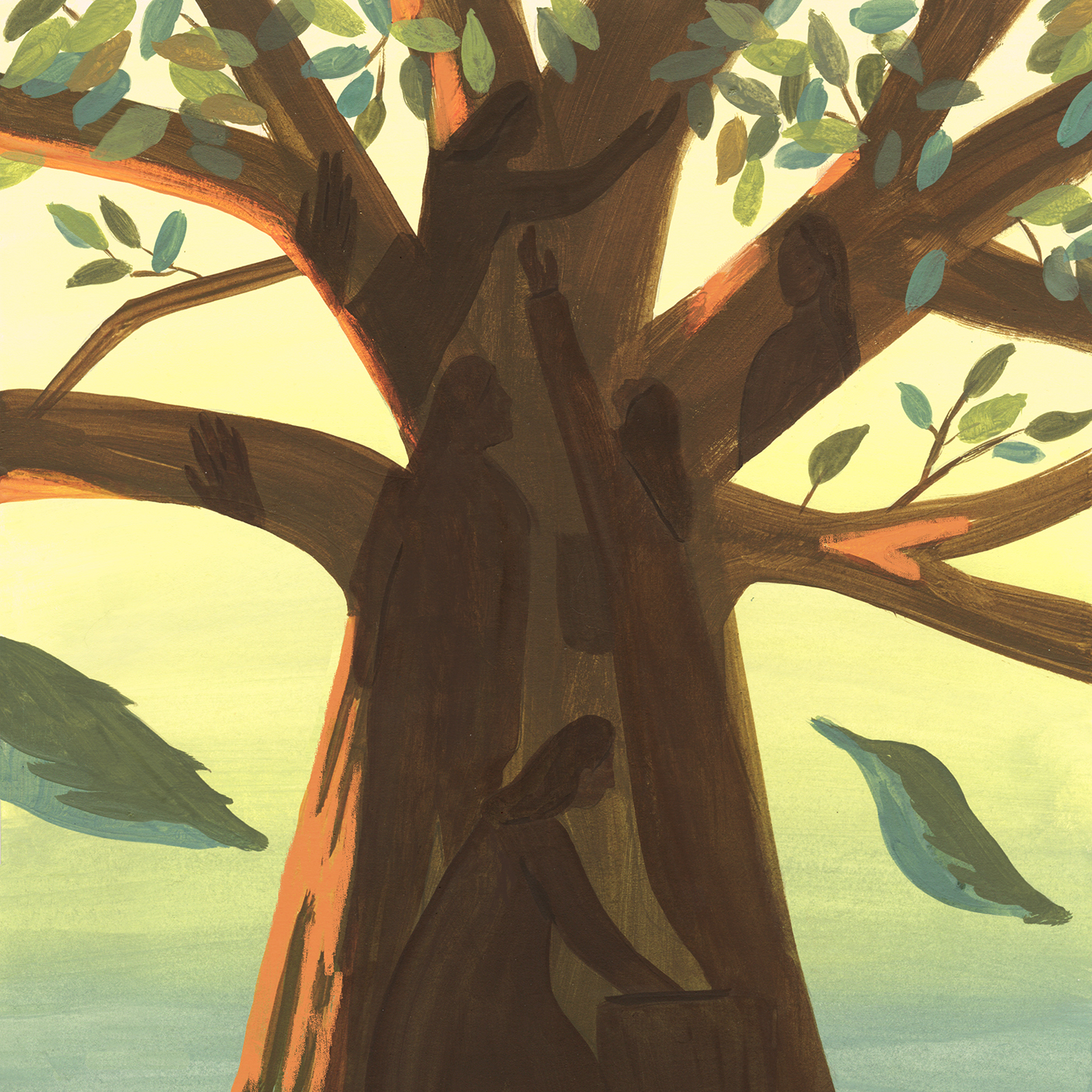
For now, while transgenic American chestnut trees are still highly regulated, one of the best places to see one is at the Lafayette Road Experimental Field Station on the southern outskirts of Syracuse. Powell met me there on a sunny July morning two summers ago.
On fields that glowed bean-pod green in the upstate humidity, thousands of chestnut trees grew in varying stages of reproduction, healing, and death. White paper bags festooned the taller trees, their flowers covered to manage fertilization.
The transgenic chestnuts contain wheat DNA that lets the tree create an enzyme that fights off Cryphonectria parasitica, the fungal blight. The blight cankers on these trees don’t grow big enough to girdle them.
Rows of strappy transgenic saplings, some as tall as Powell, waited in holding plots fenced to keep out hungry deer. “We’re planting them on very close spacing, and we can only hold them for about three years, and then they get root-bound,” Powell said. As the permitting process drags on, time is running out to replant these young trees.

I asked Powell why he thought restoring the chestnut was important. Chestnuts produced a stable crop of nuts for wildlife, because they flowered late enough in the year that they escaped flower-killing frosts, he said. “It was just an important part of our ecosystem, and for our heritage, too,” he added. “The railroads that were made in the East used ties that were made out of chestnuts because they were rot resistant. And people used to say, chestnuts used to follow you from cradle to grave, because the wood was used in everything from cradles to coffins.”
Although he’s retired, Powell is working to create a research center that would develop transgenic versions of other native species going extinct from blights, insects, and other introduced pests. He imagined growing transgenic versions of everything from elms, killed off by Dutch elm disease and the elm yellows pathogen, to ash trees, which are currently being devoured by iridescent green beetles called emerald ash borers.
People who hope to use technology to resurrect extinct species, whether the American chestnut or even the woolly mammoth, are sometimes considered ecomodernists. According to Jason Delborne, who studies biotechnology and environmental policy at North Carolina State University (where I previously worked, in the English department), “There are people who are environmentalists at their core, but sick of losing, and interested in the promise of technology to solve the ecological and environmental problems we are facing.” Part of that interest, he said, comes from a sense of responsibility to “fix what you broke.”
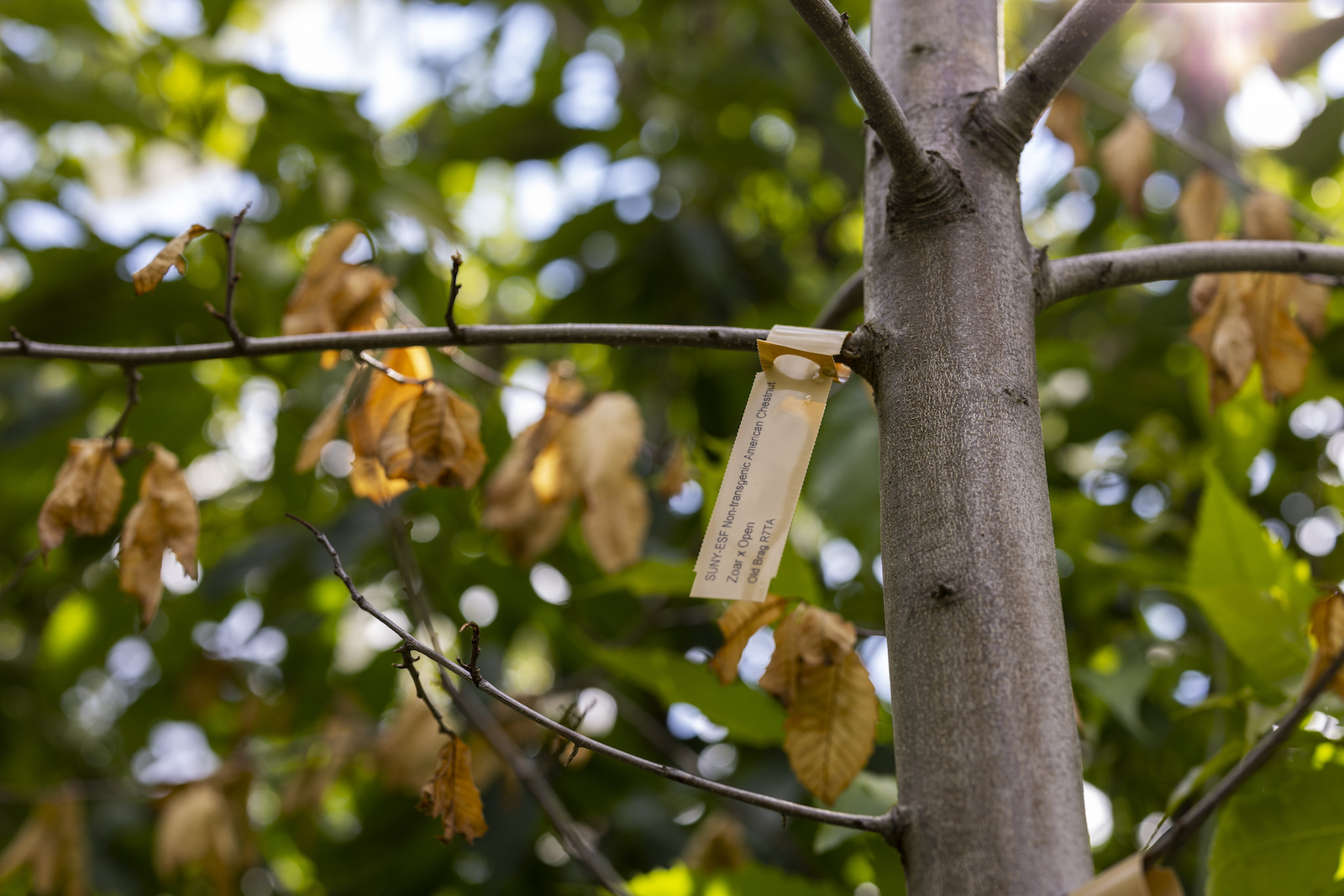
Indeed, Jamie Van Clief, the southern regional science coordinator for The American Chestnut Foundation, explained to me that she got interested in working for the organization because her field, environmental science, was depressing.
“There’s a lot of disaster, there’s a lot of dismay, and to have this foundation with such a positive and impactful mission just attracted me immensely,” she said. “To be able to work towards something when it kind of feels hopeless sometimes — and to be part of restoration on the scale that we’re doing — is incredible.”
As Powell and I gazed at a diseased, non-engineered chestnut sapling, its yellowing leaves hanging limp in the sun, I reflected that eastern forests weren’t exactly flush with any other giant trees. Almost all old growth has fallen to human endeavors. Conservation efforts also have to take into consideration climate change, which may shift suitable chestnut habitat north into Canada — and shift plant diseases’ habitats as well. Root rot, or Phytophthora cinnamomi, is another introduced pathogen. It only infects chestnuts in the South right now, because root rot dies during winter freezes. The American Chestnut Foundation estimates root rot will spread to New England in the next 50 years as the region warms. Plus, there are few places available for a new chestnut forest to grow, except perhaps forest remediation sites such as old Appalachian coal mines. The fact is, releasing blight-resistant chestnuts into the wild won’t guarantee them a landscape where they can survive.
Because biotechnology alone can’t restore the American chestnut to the numbers that its supporters are envisioning, Powell anticipates relying on citizen scientists. After deregulation, he imagines The American Chestnut Foundation sending transgenic pollen to interested people, who could pollinate the flowers of wild mother trees growing nearby. They could plant the nuts the trees grow or pass them on to other chestnut fans.
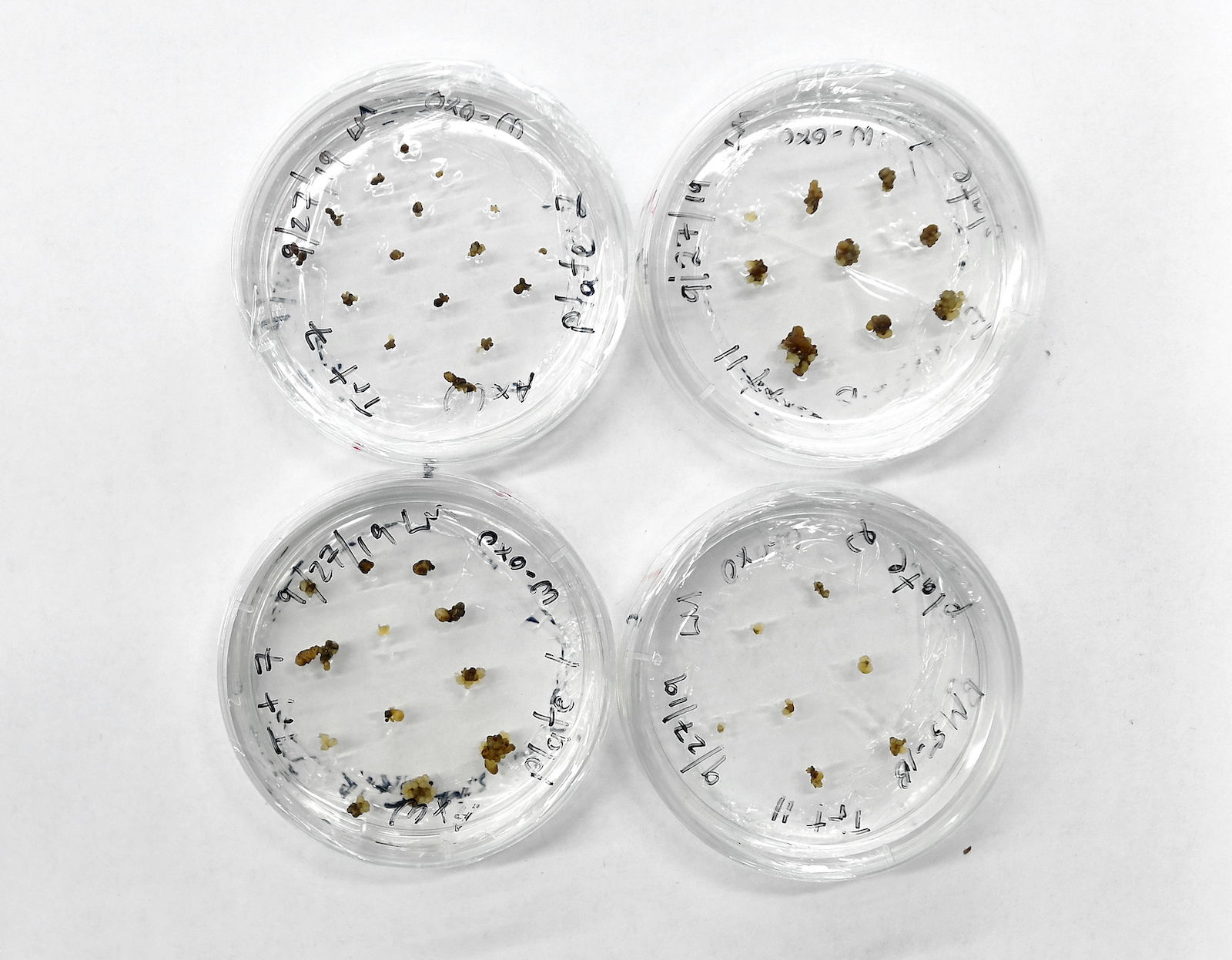
The health and ecological risks of introducing the transgenic chestnut into the wild are likely to be low, according to Delborne; its signature wheat gene is commonly found in many major food crops. But at heart, Delborne argues, the debate isn’t just about chestnuts. “It’s also about a category of technology that could find its way into the world,” he said.
Even if the chestnut recovery doesn’t work out, the approval of the engineered chestnut for unregulated growth could open the door to a new era of biotechnology in U.S. forestry — such as a pest-resistant poplar tree, which kills forest insects by expressing genes from the bacterium Bacillus thuringiensis, and already grows commercially in other countries.
The debate about blight-resistant chestnuts isn’t really about trees or even genetic engineering; it’s about who gets to make decisions on the land. Conservation is framed in European cultures as an objective goal, but it’s a worldview that other people may not share, explained Katie Barnhill-Dilling, a North Carolina State University social scientist who researches environmental decision-making. “Some of the people I’ve talked to from the Haudenosaunee Environmental Task Force would contest that humans are here to accept the gifts as they are now,” she said.
Some Indigenous nations in the chestnut’s historic range, such as the Eastern Band of Cherokee Indians, or EBCI, are considering growing genetically engineered chestnuts on their reservation lands after the trees are deregulated. To EBCI Secretary of Agriculture and Natural Resources Joey Owle, restoring the American chestnut is another way for the tribe to exercise its sovereign rights, more than a century after the tree’s disappearance.
“It’s one project of many projects that we work on to enhance our sovereignty as a tribe, to work to establish a culturally significant resource that provided a bountiful harvest for our ancestors and wildlife,” he said. “It’s just cool to be part of it.” Based on feedback from EBCI committee members, Owle said that planting transgenic trees, while an option, is the “last option that we would like to pursue” to restore the species. For now, the EBCI is scouting out wild chestnuts that survived the blight, and planting hybrid trees on its land in partnership with The American Chestnut Foundation.
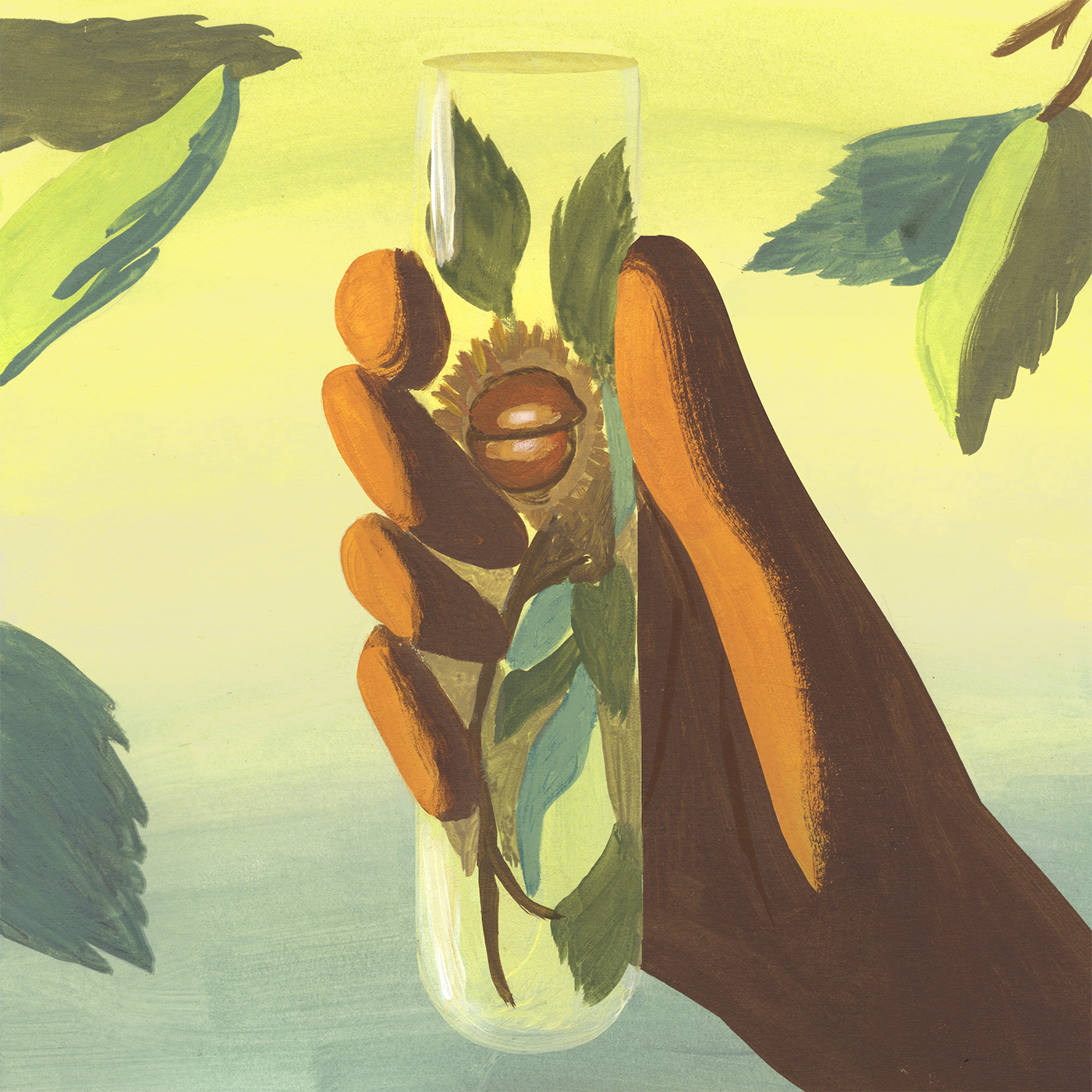
On a crisp fall day a couple of years ago, Patterson and Powell arranged for around 15 people to gather chestnuts in upstate New York. The grove grew on a hilly slope on state land that used to be an agricultural field. “It was just a beautiful little spot,” Patterson recalled. The 12 or so American chestnuts were young; Patterson estimated they were perhaps 20 years old and no more than 25 feet tall.
The group, a mix of Haudenosaunee Confederacy members and non-Indigenous scientists, toted assorted equipment to gather the prickly nuts: ladders, homemade pickers, plastic buckets, sturdy leather shoes, and gloves. But first, they stood in a circle in the grove and discussed the future of the American chestnuts. According to Patterson, things quickly became adversarial.
Powell and Patterson had long been collegial: Patterson first tasted an American chestnut after he microwaved some that Powell handed him in the campus building where they both had offices. Meanwhile, Powell’s students learned from Patterson about the parallel expulsion of Indigenous peoples from their lands and the disappearance of chestnut trees.
Powell has constantly reached out to tribes for input and to understand their perspectives, Patterson said. And unlike other biotechnology researchers, Powell has focused on technology for environmental restoration, not for personal profit. “I admire the idea that this is about technology for restoration — whatever that is,” Patterson added.
But their relationships with plants remain fundamentally different. For example, Powell has talked about keeping the price of the transgenic chestnuts low, just to raise enough money to cover the costs of getting them out to people. In contrast, when I asked Patterson why he never bought or sold seeds from traditional food plants for his home garden, he sounded incredulous. “That’s like selling people,” he said. “That’s life. … Why would you sell somebody?”
That fall day, Patterson began worrying that if the restoration succeeds and transgenic chestnuts grow across the land, releasing pollen into the wind, people won’t be able to tell transgenic trees apart from non-transgenic trees. Scientists in the group assured everyone that in the future, people would be able to tell the trees apart through genetic testing.
“It was this privileged standpoint, which is, ‘Well, technology will figure it out for us.’ But it’s not as if I’m going to hand that technology to my son or nephews or my grandsons before they go off to gather,” Patterson said. “It just seemed like it was so simple to them.” He wondered why the non-Indigenous scientists and conservationists had been able to plant this grove on state land in the first place, when his nation was largely prevented from accessing or caring for plants there.
The group got tense. “The conversation turned to fear, and to moral opposition,” Patterson recalled. Patterson realized this standoff wasn’t the right frame of mind for the trip. “Well,” he exclaimed, “let’s go pick some nuts!”
As he collected chestnuts, Patterson couldn’t help but think of Ernest Smith’s painting. “It was a fulfillment of that scene,” he told me. Patterson reflected on his ancestors, wondering how they’d gathered the prickly nuts without his contemporary tools. He felt that by collecting chestnuts, he was doing what he was supposed to do. He hoped that in the future, he’d be able to find more wild chestnuts and organize more gathering trips, taking care to bring Haudenosaunee kids along. But he could see that the masting trees were struggling with the blight and weren’t going to survive much longer. Some of the young trees were already more than half dead, leaves brown and wilted.
He and his wife, who also attended the trip, were struck by a realization: If the federal government deregulated the blight-resistant trees, letting their pollen float freely through the air, this trip might be one of the last times they could gather wild American chestnuts with certainty.
*Correction: An earlier version of this story incorrectly stated that Patterson’s relatives participated in the occupation of Alcatraz Island. Due to editing errors, the earlier version also incorrectly listed the Indigenous nations considering growing genetically engineered chestnuts and misidentified an 1885 print of a European chestnut.
This story was originally published by Grist with the headline The American chestnut tree is coming back. Who is it for? on Sep 13, 2023.

This story is part of Record High, a Grist series examining extreme heat and its impact on how — and where — we live.
Janae Van de Kerk works as a passenger service assistant at Phoenix Sky Harbor International Airport. It’s demanding work, requiring her to push wheelchair-bound passengers wherever they need to go — through terminals and jetways, on tarmacs, into parking lots. During the city’s record-breaking hot streak this summer, Vandekirk spent most days nursing a headache or feeling sweat soak her uniform as she slogged through temperatures as high as 118 degrees Fahrenheit.
By way of protection, the airport gave her and her coworkers a 10-minute briefing on the basics: Drink fluids. If you’re not feeling well, sit down.
Ah, but there’s a catch.
“We’re not allowed to sit down unless we’re on an official break,” said Van de Kerk, and those come few and far between. By the time workers who request a breather get to the one break room available to them, their 20-minute allotment is all but over.
On August 24, Van de Kerk and 11 of her fellow airport service workers — from passenger service assistants like her to baggage handlers and cabin cleaners — filed a complaint with the Occupational Safety and Health Administration, or OSHA. The employees, supported by Service Employees International Union, requested an inspection of working conditions they say leave them vulnerable to heat illness and exhaustion.
It is the first heat-related OSHA complaint from U.S. airport workers. The move comes after years of increasingly unbearable summers in Arizona and the Southwest that have seen temperatures increasingly ascending well into triple digits, but it could have ramifications much farther afield. Advocates hope it could motivate the agency, which governs workplace safety, to consider a blanket federal extreme heat standard for American workers. Such calls have come to a head in the record-shattering summer of 2023 and follow protests in Phoenix and beyond. A thirst strike in Washington, D.C., led by Texas Representative Greg Casar called attention to similar workers’ plights in his home state, while airport service workers at Dallas-Fort Worth International Airport have spoken out about their conditions.
In July, the Biden administration took steps to address the mounting problem, introducing an OSHA enforcement initiative on extreme heat that would ramp up workplace inspections in high heat areas and issue hazard alerts to employers. Phoenix airport workers hope their complaint will push the agency to rigorously enforce these regulations.
In the complaint, workers also reported a lack of adequate medical attention for workers experiecing obvious heat illness. “The time that I suffered from extreme fatigue weakness I told my supervisor,” Linda Ressler, a cabin cleaner, reported in the written complaint. “She told me that I can either go home or she can get me an ambulance. I didn’t want to get the ambulance, because I don’t have money to pay. I was also in and out of conscious[ness] and was confused and didn’t know what to do.”
Workers like baggage handlers and runway signalers who direct aircraft on the tarmac are obviously most at risk from dangerous heat exposure. But cabin cleaners can experience stifling conditions when plane engines and air conditioning are turned off during layovers and the jet feels like a superheated aluminum can.
“They definitely are the invisible people,” Van de Kerk said. “Passengers don’t see them.”
According to Service Employees International Union, inflation-adjusted wages for airport service workers have not risen in 20 years. Unlike flight attendants, these employees are not often unionized, instead contracted by the airline to work in a specific terminal, despite the fact that the airline controls the conditions of their workplace. These folks also are disproportionately people of color, and many are immigrants.
Van de Kerk, for example, is not an official employee of the Phoenix airport or any specific airline. She is a contract worker for Prospect Airport Services. Arizona is a low-bid state, so the airport hired the company that required the least amount of money. Employees earn minimum wage. And the company, as a third party, doesn’t fall under most basic protections for workers. “Contract workers have nothing,” Van de Kerk said. “We have no voice.”
Phoenix has been so hot this summer that people have received third-degree burns from touching asphalt. Local emergency rooms have been inundated with patients exhibiting signs of heat-related illnesses. At the airport, cabin cleaners describe drinking water from the bottles passengers leave behind just to stay cool as the cabins they worked in reached unimaginable temperatures.
Prospect Airport Services did not respond to a request for comment.
Advocates say there is a chance to change things within the airline industry soon. The Federal Aviation Administration’s reauthorization deadline is less than a month away. Labor unions consider it a chance for Congress to require better wages and sick leave for airport service workers. If argued right, that could also include developing safety protocols for workers in dangerously hot conditions.
This story was originally published by Grist with the headline The fight for worker safety protection heats up at the Phoenix airport on Sep 13, 2023.
There is no safe level of lead. The naturally occurring metal is so toxic that the Environmental Protection Agency began banning its use in paint and gasoline in the 1970s, following the lead of other countries. Since then, a growing body of research has confirmed the health effects of lead exposure, including heart and kidney diseases. The effects are particularly pronounced in children. Exposure to lead in the first five years of life has been shown to hinder brain development, stunting a child’s ability to learn, focus, and control their impulses.
A new study from the World Bank tallies the staggering worldwide toll: 5.5 million deaths from heart diseases because of exposure to lead in 2019 alone. Researchers also found that exposure to lead in children under five years old led to a loss of more than 750 million IQ points — a standardized measure of intellectual ability. People in low and middle income countries, where blood lead levels are higher on average than in high income countries, were hit hardest. The overall cost of exposure was $6 trillion in 2019, the equivalent of nearly 7 percent of the world’s economic output.
“There has been this idea that since the phase out of lead in gasoline [in the 1970s], the problem has more or less been solved,” said Bjorn Larsen, a consultant with the World Bank and lead author of the study. “Our estimate indicates that the health effects and the cost of lead exposure is possibly as large as the health effects and costs of fine particulate ambient air pollution and household air pollution combined. That is enormous.”
The study, published in the journal Lancet Public Health on Monday, relied on blood lead level estimates in a 2019 study that aggregated data sources on health and mortality outcomes worldwide. Larsen and his co-author then used existing research on the effects of lead to calculate IQ loss in children and deaths from cardiovascular disease in adults. They also estimated the economic costs of the loss in IQ and deaths. The findings were “surprising,” Larsen said.
IQ losses were about 80 percent higher and the number of deaths from cardiovascular disease was six times higher than previous estimates. Larsen attributed the difference to improvements in our understanding of the effects of lead exposure and a more comprehensive methodology that better captured how exposure could cause cardiovascular diseases.
Blood lead levels in American children have dropped dramatically in the last few decades. In the 1970s, kids between the ages of one and five years old were found to have 15 micrograms of lead in each deciliter of blood. That figure dropped to 0.6 micrograms in 2017. But in low and middle income countries the researchers found that the average is still about 4.6 micrograms per deciliter, which Larsen said drove the findings on IQ loss and cardiovascular disease.
There are many factors causing higher levels of blood lead levels in lower income countries. Lead battery recycling units may contaminate the air, water, or soil in and around population centers. Aluminum pots and pans might be tainted with lead that eventually leaches into food. Leaded paint is also still used in many countries, and lead has been found in phosphate fertilizers, which could be contaminating crops. It’s unclear which of these sources are driving elevated levels of blood in lower income countries.
Larsen said that governments and aid organizations should routinely test children to get a better understanding of lead exposure. And that, in turn, could help identify hot spots and potential sources of the toxic metal.
“The understanding of these sources is very incomplete,” said Larsen. “We are decades behind on lead, because it has been a neglected area up until now.”
This story was originally published by Grist with the headline Study: Lead exposure killed more than 5 million people in just one year on Sep 12, 2023.
A new study from Oxford University and Regulatory Assistance Project, an NGO, found that even in cold weather, heat pumps are twice as efficient as heating from fossil fuel sources.
Although heat pumps have been identified as an important way to transition to cleaner energy sources, there have been concerns over whether the pumps would perform adequately in lower temperatures.
Research published in the journal Joule finds that not only are heat pumps capable of operating efficiently in colder weather, but they can even outperform other heating sources, like oil, gas or electric resistive heating.
Ground-source heat pumps can be particularly efficient in cold weather, because there aren’t big changes in soil temperatures between seasons, the study authors explained. Further, the authors noted that ground-source heat pumps don’t need to use any energy to defrost, also boosting their efficiency in cold weather.
To reach these findings, the researchers evaluated the performance data from seven different field studies in mild cold climates, or areas with average temperatures above -10 degrees Celsius (14 degrees Fahrenheit) for January. The studied regions include Switzerland, Germany, the UK, Canada, China, and two field studies in the U.S. They found that the efficiency of heat pumps in mild cold climates when temperatures were between -10 and 5 degrees Celsius was much higher than heating from both fossil fuel sources and electric resistance heat sources.
The team also studied cold-climate heat pump performance in areas with extreme cold climates, or average January temperatures below -10 degrees Celsius. In this review, they found that cold-climate air-source heat pumps produced a coefficient of performance (COP) of over 1.5 at temperatures as cold as -30 degrees Celsius (-22 degrees Fahrenheit). However, the authors noted that while there are heat pumps designed specifically for colder climates, these systems aren’t the best option everywhere. They may perform less efficiently when temperatures are mild.
Ultimately, the study found that heat pumps were performing two to three times more efficiently than combustion heating or electric resistance heating. The authors noted that the findings largely suggest that heat pumps do not require a backup heating source, like a fossil fuel powered heating source, but more studies are needed to consider the value of hybrid heating systems.
Because heat pumps can cost more up front than other heating elements, consumers may be hesitant to install them. This has prompted some governments to consider incentives to transition more households to heat pump systems. For instance, the UK is considering incentive proposals to encourage more people to make the switch and is also requiring a heat pump sales quota for heating companies, The Guardian reported.
The new research could help ease concerns around the world over the effectiveness of heat pumps, particularly in below-freezing temperatures.
“Our view is that the widespread rollout of air-source heat pumps around the world as part of decarbonization efforts can be successful with existing technology in most areas that have space heating demand,” the authors concluded. “Ground-source heat pumps and hybrid air-source systems may have significant value in the coldest climates.”
The post Heat Pumps Are Twice as Efficient as Oil and Gas Heating in Cold Weather, Study Says appeared first on EcoWatch.
Fungi are like no other species on Earth. They’re not plants or animals, they thrive in damp, dark environments and have an otherworldly feel. And while their unique kingdom is the largest of any on the planet, more than 90 percent remain unidentified.
Among mushrooms’ many unique characteristics, they reproduce by glowing in the dark. Thanks to the same compounds that give fireflies and some marine creatures their glow, mushrooms light up the night to attract insects, who then spread their spores throughout the forest, according to BBC Earth.
Mushrooms live a symbiotic life with trees. Ectomycorrhizal fungi grow on tree roots, providing trees with essential nutrients like phosphorus and nitrogen. Meanwhile, fungi are getting carbon that the trees convert into sugars during photosynthesis.
A new study by researchers from the University of Minnesota and Syracuse University explores the effects of climate change — like higher temperatures and more severe drought — on fungi and the underground ectomycorrhizal networks that fungi form in order to enable the transfer of minerals and water between trees, a press release from Syracuse University said.
“The interaction networks formed by ectomycorrhizal fungi (EMF) and their tree hosts, which are important to both forest recruitment and ecosystem carbon and nutrient retention, may be particularly susceptible to climate change at the boreal–temperate forest ecotone where environmental conditions are changing rapidly,” the researchers wrote in the study.
The study, “Climate change–induced stress disrupts ectomycorrhizal interaction networks at the boreal–temperate ecotone,” was published in the journal Proceedings of the National Academy of Sciences.
For the study, the research team exposed temperate and boreal tree species to higher temperatures and drought in order to examine how they and their fungi partners would respond, the press release said.
The boreal ecosystem exists in the northernmost forests of the planet, while the temperate ecosystem can be found between the boreal and tropical regions. Ectomycorrhizal fungi colonize tree roots of many species where these two ecosystems meet. A mixture of temperate trees can be found in this area, like oak and maple, as well as boreal trees like evergreens.
The research team found that the combination of increased temperatures and water stress will likely cause major disruptions to ectomycorrhizal networks that may damage forest function and resilience.
The researchers conducted their study in Minnesota at an ongoing climate change experiment, Boreal Forest Warming at an Ecotone in Danger (B4WARMED). The long-term experiment has temperate and boreal tree species that have been exposed to the environmental extremes of warming and drought.
Leader of the study Christopher W. Fernandez, an assistant professor of biology in the College of Arts and Sciences at Syracuse University, said the findings of the study showed that the composition of ectomycorrhizal fungal species shifts markedly when exposed to climate change.
The research team detected a shift from mature forest species with a high biomass mycelium — the hair-like body of the fungus that goes on exploratory missions through the soil — toward species with low biomass usually found in ecosystems that have been highly disrupted.
“There is a supported hypothesis that these low biomass species probably do not provide the host much benefit in terms of nutrition compared to high biomass species,” Fernandez said in the press release. “We found that the networks formed by these fungi that ‘connect’ the trees shifted from relatively complex and well-connected networks to ones that are simpler with less connections.”
The study’s authors said the shifts were closely related to tree hosts’ performance and ability to use photosynthesis to convert carbon into sugars and oxygen.
“Climate change is reducing the amount of carbon the trees fix and likely has cascading effects on how much carbon they can provide to their ectomycorrhizal fungi,” Fernandez said. “This is likely causing a shift towards low biomass species, resulting in the breakdown of networks between trees.”
The researchers said the next step is to connect ectomycorrhizal network changes to carbon and nutrient cycling and other ecosystem processes to see how well they handle climate change.
The post Climate Crisis Is Breaking Down Fungi-Tree Communication Networks, Study Finds appeared first on EcoWatch.
In a first-of-its-kind hearing, small island nations disproportionately affected by the climate crisis are taking high-emitting countries to court. The suit is being viewed as the first climate justice case with the goal of protecting the ocean.
The prime ministers of the islands of Barbuda and Tuvalu, acting as representatives of Small Island States on Climate Change and International Law (COSIS), are presenting evidence at the International Tribunal for the Law of the Sea in Hamburg, Germany. They are seeking an advisory opinion on what obligations countries have to safeguard the marine environment in the face of climate change.
The tribunal will also consider if carbon and other greenhouse gases that are absorbed by the ocean should be included in marine pollution, reported Reuters.
“We come here seeking urgent help, in the strong belief that international law is an essential mechanism for correcting the manifest injustice that our people are suffering as a result of climate change,” said Prime Minister of Tuvalu Kausea Natano, as Reuters reported.
Too much carbon in the ocean leads to acidification and coral bleaching. Low-lying island nations also face the threat of sea level rise, which could submerge them by 2100.
The opinion of the tribunal will not be legally binding, but present an authoritative legal statement for future guidance to countries in formulating laws regarding climate protection.
Natano said Tuvalu had not received any help despite seeking it for decades, reported The New York Times.
The prime minister said the island “will become mostly uninhabitable, if not inundated, in the next few decades. More than 10,000 people will be forced to leave,” The New York Times reported.
The Paris Agreement requires nations to reduce their emissions and states the objective of limiting global heating to well below two degrees Celsius, but countries are allowed to formulate their own plans of action to meet these goals.
Estimates have suggested that half of Funafuti, the capital of Tuvalu, will become flooded by mid-century, reported The Guardian.
“Extreme weather events, which grow in number and intensity with each passing year, are killing our people and destroying our infrastructure. Entire marine and coastal ecosystems are dying in waters that are becoming warmer and more acidic,” Natano said, as The Guardian reported.
Natano said he had confidence in international tribunals and courts not allowing climate change threats to his island to continue unabated.
“Some of these states will become uninhabitable in a generation and many will be submerged under the sea. This is an attempt to use all the tools available to force major polluters to change course while they still can,” said Payam Akhavan, lead counsel and chair of legal experts for COSIS, as reported by The Guardian.
The post Small-Island Nations Take Heavy Polluting Countries to Court Under Law of the Sea appeared first on EcoWatch.
Cows are often described as climate-change criminals because of how much planet-warming methane they burp. But there’s another problem with livestock farming that’s even worse for the climate and easier to overlook: To feed the world’s growing appetite for meat, corporations and ranchers are chopping down more forests and trampling more carbon-sequestering grasslands to make room for pastures and fields of hay. Ruminants, like cattle, sheep, and goats, need space to graze, and animal feed needs space to grow. The greenhouse gases unleashed by this deforestation and land degradation mean food systems account for one-third of the world’s human-generated climate pollution.
Environmental advocates have long argued that there’s a straightforward solution to this mess: Eat less meat. Convincing more people to become vegetarians is a very effective way to limit emissions. Getting rid of meat is one question; replacing it is another. A paper published on Tuesday seeks to address both, finding that giving up meat in favor of meat-like plant products would yield significant benefits for the climate, biodiversity, and even food security in coming decades.
Swapping 50 percent of the world’s beef, chicken, pork, and milk consumption with plant-based alternatives by mid-century could effectively halt the ecological destruction associated with farming, particularly in Sub-Saharan Africa, China, and Southeast Asia, according to the study in Nature Communications. Such a dietary shift could also lead to a 31 percent reduction in agricultural greenhouse gas emissions by 2050, the study found. That’s the equivalent of not burning 1.8 trillion pounds of coal each year between 2020 and 2050.
Climate policies and investment focus heavily on fossil fuels and the energy sector, but slashing agricultural emissions is also crucial to keeping planetary warming below catastrophic levels, said Lini Wollenberg, the study’s co-author.
“There’s enough evidence to show that if we don’t shift our diets, then we will not meet the 1.5 degree Celsius target by 2100,” said Wollenberg, who researches climate change and food systems at CGIAR and the University of Vermont. “Agriculture has to be addressed.”
Most of the emissions saved by a shift to plant-based foods, like oat milk and Impossible Burgers, would come from staving off agricultural expansion and preserving land. Under a model that assumes the status quo continues, demand for meat would continue to rise globally, and overall land devoted to agriculture would grow by 4 percent — 219 million hectares, about seven times the size of Germany — by 2050. But if people replace half of the meat and milk that they eat with analogs made from plants over the same time period, land used for feeding and keeping livestock would shrink by 12 percent — 653 million hectares, roughly twice the size of India. Sparing that land also would help limit biodiversity loss and conserve water, the researchers found.
“It was interesting to see how powerful this dietary change can be and to see all these impacts across the spectrum of sustainability outcomes or objectives,” said Marta Kozicka, an agricultural economist at the International Institute for Applied Systems Analysis in Austria and the paper’s lead author.
The study doesn’t provide a detailed roadmap for overhauling the world’s diet. The United Nations projects that people around the world will be eating 14 percent more meat in 2030. Even as plant-based foods take up more shelf space at grocery stores in the United States than they did five years ago, the foods still make up less than 2 percent of the meat sold in the United States (though a bit more – 15 percent – of the country’s milk).
The paper’s authors acknowledge that replacing half the world’s meat and milk consumption by 2050 “will be challenging and may require a range of technological and policy interventions,” though they conclude that such a scenario “is a realistic one, especially if the novel plant-based alternatives may be combined with traditional plant-based products and other novel meat substitutes, whether cell-based or insect-based.”
Raychel Santo, a food and climate researcher at the World Resources Institute who was not involved in the study, pointed to three areas where people are working to help ease global demand for meat: getting public schools, prisons, and other institutions to substitute meat on their menus with more climate-friendly options; adding labels to food products to indicate their carbon (or methane) footprints; and increasing public funding for research and development of alternative proteins.
“Right now there is very limited public investment in alternative proteins,” Santo said, noting that other climate solutions, like renewable energy and electric cars, have gotten considerably more financial backing from the U.S. government. Santo called the goal of cutting the planet’s meat consumption in half by 2050 a “tall order,” but she also pointed out that previous research has found that just lowering the consumption of ruminant meat alone could halt agricultural expansion and deforestation. That leaves room for replacing red meat with chicken — a shift that many Americans have made in recent decades, mostly due to health concerns.
Some advocates hope that advances in technologies like fermentation and cultivated meat will help displace demand for animal flesh. Chicken patties grown in labs may pick up where beet-bleeding burgers left off.
“Writing off alternative proteins today would be like writing off solar power in the 1980s or writing off electric vehicles in the early 2000s,” said Emma Ignaszewski, associate director at the Good Food Institute, a think tank that promotes meat and dairy alternatives, in an email to Grist. “Transforming the $1 trillion dollar global meat market will take time and continued innovation. Getting to 50 percent market share by 2050 would be a moonshot. But by no means would it be impossible.”
This story was originally published by Grist with the headline What would happen if the world cut meat and milk consumption in half? on Sep 12, 2023.
Once a native species of Florida, American flamingos mostly disappeared in the state due to hunting around the turn of the twentieth century. These days they are mostly found in the Caribbean and Central and South America.
Recently, the exotic birds — whose pink feathers come from their diet of brine shrimp and algae containing carotenoids — have made their way into Florida, the Carolinas and as far north as Ohio, Kentucky and Pennsylvania after being blown off course by last month’s Hurricane Idalia.
“The flamingos were just hanging out and sleeping in about a foot of water near the shore,” said Jacob Roalef, a birdwatching guide from Ohio, as CNN reported. “They would wake up and drink some water or look up if a gull flew overhead.”
According to eyewitnesses, some of the flamingos in Florida appear to have come from the Yucatán peninsula, reported The Guardian.
“They continue to pop-up along the Gulf, including here in Treasure Island. They were brought in from Cuba on the back-end of Hurricane #Idalia. Be on the lookout this weekend if you’re going to the beach, might be lucky enough to see a few!” Matt Devitt, chief meteorologist at WINK News in Southwest Florida posted on X.
At the Outer Banks in North Carolina, flamingos were spotted at the Pea Island National Wildlife Refuge, according to The Virginian-Pilot.
“It’s a special experience because… after a while, you get used to seeing all the common birds that are here; so to see something different is really uplifting,” said retired U.S. Army doctor Loren Erickson, as The Virginian-Pilot reported.
Nate Swick, digital communications manager for the American Birding Association, said it was likely that the flamingos were swept up by Hurricane Idalia, reported NPR. Swick said, while it was a “fairly common phenomenon,” it’s not something that typically happened with flamingos.
“We’re seeing flamingos all over the place. We’re seeing them in places that we didn’t expect them,” Swick said, according to NPR.
Swick explained that the rare birds might have gotten caught up in the winds of the storm in the Yucatán or while they were flying to Cuba, or in its eye and went with it until it calmed down.
“We have never seen anything like this,” said Jerry Lorenz, the state director of research for Audubon Florida, as CNN reported. “We will get a flamingo or two following storms [but] this is really unprecedented.”
Cory Christopher, Cincinnati Nature Center’s director of conservation, told a local outlet that the flamingos will likely be able to make their way home, reported The Guardian.
The post Flamingos From Mexico Seen From Florida to Ohio After Being Blown Off Course by Hurricane Idalia appeared first on EcoWatch.
The U.S. Energy Information Administration (EIA) announced that new small-scale solar capacity, or rooftop solar capacity, in the U.S., reached a new high in 2022. The administration estimated that 6.4 gigawatts (GW) of rooftop solar capacity was added last year, the most ever added in a single year.
Since EIA started publishing updates in small-scale solar capacity in 2014, capacity increased from a total of 7.3 GW to 39.5 GW in 2022. About one-third of all solar capacity in the U.S. is small-scale solar, defined as solar power systems with less than 1 megawatt (MW) capacity.
According to the administration, capacity from residential rooftop solar panels makes up the most of total small-scale solar capacity in the country.
“Tax credits and incentives, public policy, and higher retail electricity prices have encouraged the growth of small-scale solar capacity over the past decade. Falling solar panel costs have also played a significant role,” EIA shared on its website.
Newly installed small-scale solar is increasing particularly in California, which has the largest amount of small-scale solar (14.2 GW) in the U.S., about 36%. This can be attributed to the climate of the area as well as the state’s Building Energy Efficiency Standards (Energy Code), which requires newly constructed single-family and multifamily homes that are one to three stories to install solar panels. California also has plenty of incentives, like rebate programs and tax exemptions, that lower the average cost for homeowners to convert to solar power.
New York and New Jersey also have higher shares of small-scale solar capacity in the U.S., at 2.6 GW and 2.4 GW respectively, followed closely by Texas (2.2 GW) and Arizona (2.1 GW). But when considering small-scale solar capacity per capita, Hawaii takes the lead with 541 watts per capita. California follows with 364 watts per capita.
“A large share of Hawaii’s electricity has historically come from oil-fired power plants. These plants rely on expensive fuel imports, resulting in high electricity bills,” EIA stated. “As solar panel costs have fallen, many homes and businesses in Hawaii have added solar panels, reducing their electricity bills and helping the state work toward its target to generate 100% of its electricity from renewable sources by 2045.”
Increasing small-scale solar capacity accompanies growing utility-scale electric-generating solar capacity in the U.S. Earlier this year, EIA predicted that 54% of new electric-generating capacity in the U.S. could come from solar power. Additionally, 2023 could see the highest amount of utility-scale solar capacity to be added in a single year.
The post Newly Added Rooftop Solar Capacity in the U.S. Reached Record High in 2022 appeared first on EcoWatch.